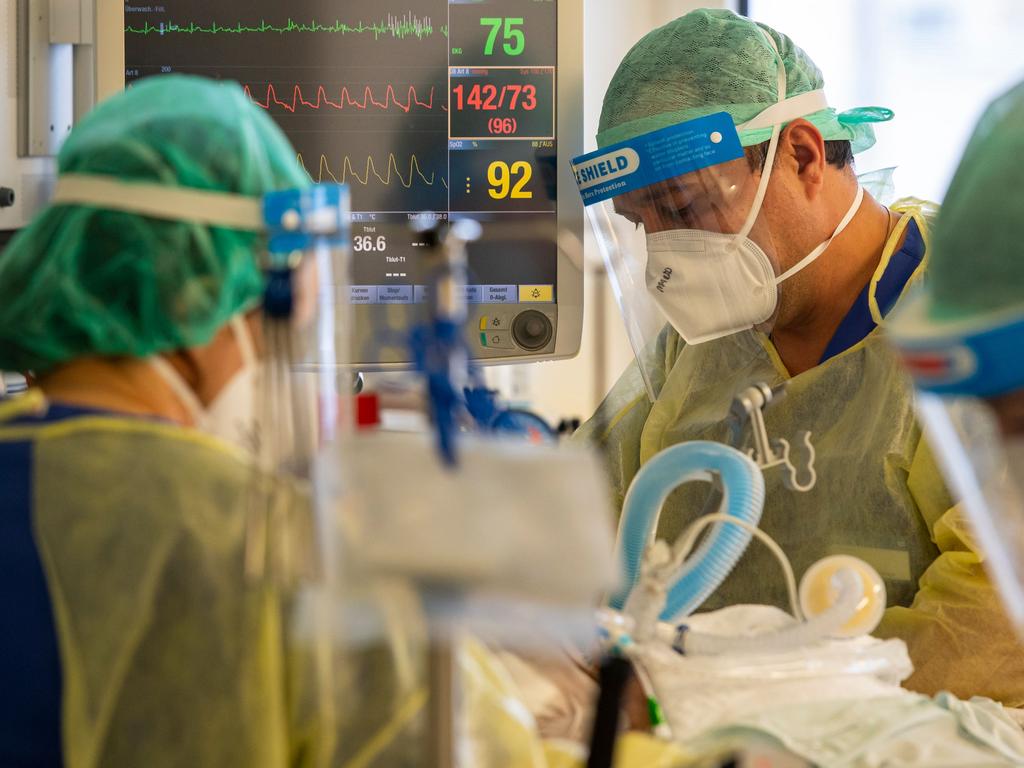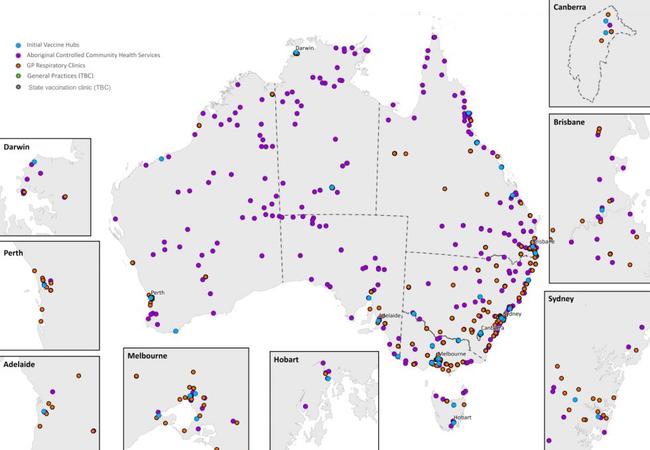When and where you will be able to get the COVID-19 vaccines
Six million more Aussies are now able to receive the COVID-19 vaccine. This is everything you need to know about how the rollout is working.
The Australian government has spent months creating the perfect plan for the COVID-19 vaccine rollout, ensuring the country’s most vulnerable groups receive the jab as quickly as possible.
The vaccine rollout, which one expert said will need “NASA-like logistics” to execute, began on Sunday, February 21, after the Therapeutic Goods Administration (TGA) approved the Pfizer vaccine and the Oxford-AstraZeneca vaccine
RELATED: PM’s message to all Australians
RELATED: What are the potential side effects of vaccine
HAVE YOUR SAY: Will you get vaccinated?
The plan is to roll the vaccines out in five phases, with the first phases, which are already underway, covering people most at risk of contracting or developing a serious illness from the virus.
Vaccinating against COVID-19 is the easiest way for Australians to get their normal lives back, but millions are hesitant to get the jab.
Our Best Shot is news.com.au’s campaign answering your questions about the COVID-19 vaccine roll out.
We’ll debunk myths about vaccines, answer your concerns about the jab and tell you when you can get the COVID-19 vaccine.
Here is everything you need to know about the rollout.
WHO WILL GET IT FIRST?
The first Aussies to receive the COVID-19 jab are frontline healthcare workers, quarantine and border workers, aged care and disability care staff and aged care and disability care residents.
This is Phase 1a of the rollout and will include about 678,000 people.
Almost 200,000 people have been vaccinated so far under the first phase of the immunisation program.
The next step, Phase 1b, is now under way and will include people aged 70 and over, other healthcare workers, Aboriginal and Torres Strait Islander people aged 55 and over, people with a disability or underlying medical condition and critical and high-risk workers, such as emergency services, defence personnel and meat processing staff.
This phase will cover an estimated 6.1 million people.
Australians in this phase can now book an appointment to get their jab.

Next up in Phase 2a, will be 50-69 year olds, Aboriginal and Torres Strait Islander people aged 18-24 and other critical and high risk workers. About 6.5 million people are expected to be vaccinated in this phase.
It will probably be at least mid-year before the broader population will have access to the vaccine.
Phase 2b will include the rest of the population aged 16 and over, with the vaccine to be offered to 6.6 million Australians.
The final part of the rollout, Phase 3, will include people under the age of 16 who didn’t meet the criteria for the other sections.
This phase will only be commenced if recommended by health authorities.
Australians will either receive the Pfizer vaccine or the Oxford-AstraZeneca vaccine, with the former likely being administered to people in the first phases of the rollout.
The aim is to start off by vaccinating 80,000 Australian each week and slowly build that number, with plans to have the majority of the population vaccinated by October this year.
WHERE CAN YOU GET IT?
The government initially established 16 Hospital Hubs across metropolitan, regional and rural areas to administer the Pfizer vaccine to the people in first phase of the rollout.
These hubs have the facilities to correctly store the Pfizer vaccine, which must be kept below freezing temperatures.
The government is aiming to establish between 30 and 50 Hospital Hubs across the country as more vaccines doses arrive.
In NSW, the initial hubs have been set up at the Royal Prince Alfred Hospital, Westmead Hospital and Liverpool Hospital.
In Queensland, the hubs have been set ip at the Gold Coast University Hospital, Cairns Hospital and Princess Alexandra Hospital.

Victoria has set up hubs at Monash Medical Centre Clayton, Sunshine Hospital, Austin Health and University Hospital Geelong.
There have been two locations set up in South Australia at the Royal Adelaide Hospital and Flinders Medical Centre.
A hub has been set up in Western Australia at the Perth Children’s Hospital.
In Tasmania the Pfizer jab is administered at the Royal Hobart Hospital.
There is a hub at the Royal Darwin Hospital in the Northern Territory.
The Canberra Hospital in the ACT has also been made a designated hub.
From March 22, more than 1000 GP clinics across the country will begin offering vaccinations for people in the next phase of the rollout.
People will be able to locate their nearest vaccination provider online via the Department of Health website using the eligibility checker or by phoning the COVID-19 vaccination helpline.
Health Minister Greg Hunt has warned that not everyone will be able to get vaccinated immediately, with six million Australians eligible in phase 1b.
“No one will miss out, whether they live in a city or country town or a very remote area,” Mr Hunt said.
“Appointments on the service finder will increase as general practices establish their systems and vaccine supply.
“This staged scale up will align with the supply of the locally produced AstraZeneca vaccine, and as more vaccine becomes available, more services will come online.”
Mr Hunt said every Australian would have the opportunity to be vaccinated over the coming months, adding that more than 4000 GP clinics will offer vaccinations by the end of April.
Secretary of the Department of Health, Professor Brendan Murphy, said the majority of the population – who are not included in the high priority groups – will get their vaccines from GP respiratory clinics or select general practises.
“The states will be setting up some special vaccination clinics in addition to the Pfizer hubs. Aboriginal controlled health services will be set up,” he said.
“Towards the middle of the year when we’re broadening beyond the priority population … we will be looking at arrangements that pharmacies may be able to also be rolled out in the second half of the year. So most of the population will probably get it at one of those settings.”
HOW IS THE PFIZER VACCINE ADMINISTERED?
Because the Pfizer vaccine needs to be stored at -70C, administering it to priority groups will require “NASA-like logistics”, according to epidemiologist Mary-Louise McLaws.
Boxes of the Pfizer vaccine typically hold about 975 vials, each containing five doses of the vaccine.
“According to Pfizer, once opened, a box requires dry ice every five days, delivered within 60 seconds of lifting the lid, to maintain its temperature. From the first opening of a box, the full contents of 4,875 doses must be injected within 30 days,” Professor McLaws wrote in The Conversation.
“The next challenge is to have the right number of recipients at each vaccination session, arriving at the right time. Each vial takes between 30 minutes and 2 hours to defrost at room temperature, or 2-3 hours at normal refrigeration temperatures of 2-8C.
“Defrosted vials must be used within 84 hours. The vaccine must be diluted with sodium chloride and then injected within six hours.”
Before the vaccination is administered, each recipient will need to go through a screening process to check whether they are at risk of having an adverse reaction or have any medical conditions or allergies that could exclude them from getting the jab.
Once that screening is complete the vaccine will be administered, the recipient will be provided with some follow up information and the vaccination record will be entered into the Australian Immunisation Register.
The recipient will then have to receive the second dose 21 days later, when they will go through the first process again.
There have been concerns raised around international supply issues of the Pfizer vaccine, but Prof Murphy assured Australians that there would be enough doses to vaccinate everyone on time.
“Because we have got the luxury of doing this properly, we plan to make sure that we have enough vaccine to give everyone the second dose at the recommended time,” he said.
“We are not planning to manipulate the revaccination times. We are doing our planning on the basis that we can give people the recommended doses at the recommended intervals.”
HOW IS THE ASTRAZENECA VACCINE ADMINISTERED?
Health Minister Greg Hunt said the first doses of the AstraZeneca vaccine are likely to be administered in early March.
A major difference between this vaccine and Pfizer is that the government has an agreement to manufacture 50 million of the 53.8 million doses in Australia, which will be created in monthly batches by biopharmaceutical company CSL.

This means there will be no concerns about ongoing supply issues, with Mr Hunt branding the deal one of the “most important decisions of the whole pandemic”.
“That puts Australia in a vastly more secure position than almost any other country in the world,” he said.
The AstraZeneca vaccine is also much easier to store, meaning it can be managed through general practices and pharmacies.
This means there isn’t as much pressure on health workers to administer the vaccine within a specific, short time frame, making it the perfect candidate to be delivered to the majority of the population – particularly those in regional and remote areas.
The vaccination process will then follow the same steps as the Pfizer vaccine: the recipients will be screened, then the vaccine will be administered and recorded in the AIR and then they will have to receive a second dose about three weeks later.




